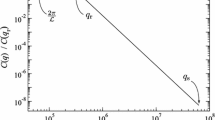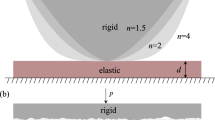Abstract
After more than two decades of development, Persson’s theory has become one of the dominantly used theoretical tools to analyze the interaction between a nominally flat rough surface and a rigid flat. The original theory (Persson in J. Chem. Phys. 115(8):3840–3861, 2001) tends to overestimate and underestimate the relative contact area and strain energy, respectively, for linear elastic purely normal contact. Several fudge factors, obtained empirically based on numerical solutions, have been used to amend the strain energy associated with each wavenumber, resulting in scale history-dependent formulations for the relative contact area and probability density function (PDF) of contact pressure, which significantly complicate the solution process. We provide a new fudge factor that results in simple formulations of the relative contact area and PDF of contact pressure, which only relies on the present scale. Compared with the relative contact area and PDF of contact pressure solved by Green’s Function Molecular Dynamics (GFMD), Persson’s theory using the new fudge factor shows similar accuracy to other variants. Among all variants of Persson’s theory, the use of the new hybrid formulation of strain energy results in the best agreement with GFMD. Using the new fudge factor, various interfacial properties (e.g., the average interfacial gap) can be derived with a simple form, and solved more quickly, with acceptable accuracy.
Graphical Abstract





Similar content being viewed by others
Data Availability
Matlab functions that implement various variants of Persson’s theory are publicly available on GitHub (https://github.com/xylcsi/PerssonModelFudgeFactor).
Notes
\(P_0(p, {\zeta })\) is continuous at \(p = 0\), i.e., \(P_0(p \rightarrow 0^+, {\zeta }) = P_0(p = 0, {\zeta }) = 0\).
This correction was initially proposed to achieve good agreement between the elastic strain energy predicted by Persson’s theory and numerical models.
References
Greenwood, J. A., Williamson, J. P.: Contact of nominally flat surfaces. Proc. Royal Soc. London. Ser. A. Math. Phys. Sci. 295(1442), 300–319 (1966)
Persson, B.N.: Theory of rubber friction and contact mechanics. J. Chem. Phys. 115(8), 3840–3861 (2001)
Majumdar, A., Bhushan, B.: Fractal model of elastic-plastic contact between rough surfaces. J. Tribol. 113(1), 1–11 (1991)
Scaraggi, M., Persson, B. N.: General contact mechanics theory for randomly rough surfaces with application to rubber friction. J. Chem. Phys. 143(22), 224111 (2015)
Persson, B.: Elastoplastic contact between randomly rough surfaces. Phys. Rev. Lett. 87(11), 116101 (2001)
Wang, A., Müser, M.H.: Gauging Persson theory on adhesion. Tribol. Lett. 65(3), 1–10 (2017)
Almqvist, A., Campana, C., Prodanov, N., et al.: Interfacial separation between elastic solids with randomly rough surfaces: comparison between theory and numerical techniques. J. Mech. Phys. Solids 59(11), 2355–2369 (2011)
Persson, B.: On the elastic energy and stress correlation in the contact between elastic solids with randomly rough surfaces. J. Phy.: Cond. Matter 20(31), 312001 (2008)
Persson, B.: On the electric contact resistance. Tribol. Lett. 70(3), 88 (2022)
Persson, B.: On the role of flexoelectricity in triboelectricity for randomly rough surfaces. Europhys. Lett. 129(1), 10006 (2020)
Persson, B.: Leakage of metallic seals: role of plastic deformations. Tribol. Lett. 63, 1–6 (2016)
Yastrebov, V.A., Anciaux, G., Molinari, J.-F.: From infinitesimal to full contact between rough surfaces: evolution of the contact area. Int. J. Solids Struct. 52, 83–102 (2015)
Afferrante, L., Bottiglione, F., Putignano, C., et al.: Elastic contact mechanics of randomly rough surfaces: an assessment of advanced asperity models and Persson’s theory. Tribol. Lett. 66(2), 1–13 (2018)
Yang, C., Persson, B.: Contact mechanics: contact area and interfacial separation from small contact to full contact. J. Phys.: Cond. Matter 20(21), 215214 (2008)
Manners, W., Greenwood, J.: Some observations on Persson’s diffusion theory of elastic contact. Wear 261(5–6), 600–610 (2006)
Xu Y, Li X, Chen Q, et al. Persson’s theory of purely normal elastic rough surface contact: a tutorial based on stochastic process theory. Int. J. Solids Struct. (2024): 112684
Dapp, W.B., Prodanov, N., Müser, M.H.: Systematic analysis of Persson’s contact mechanics theory of randomly rough elastic surfaces. J. Phys.: Cond. Matter 26(35), 355002 (2014)
Yang, C., Tartaglino, U., Persson, B.: A multiscale molecular dynamics approach to contact mechanics. Eur. Phys. J. E 19(1), 47–58 (2006)
Persson, B.: Relation between interfacial separation and load: a general theory of contact mechanics. Phys. Rev. Lett. 99(12), 125502 (2007)
Venugopalan, S., Irani, N., Nicola, L.: Plastic contact of self-affine surfaces: Persson’s theory versus discrete dislocation plasticity. J. Mech. Phys. Solids 132, 103676 (2019)
Zhou, Y., Moseler, M., Müser, M.H.: Solution of boundary-element problems using the fast-inertial-relaxation-engine method. Phys. Rev. B 99(14), 144103 (2019)
Zhou Y, Müser M H. Effect of structural parameters on the relative contact area for ideal, anisotropic, and correlated random roughness. Front. Mech. Eng. (2020): 59
Acknowledgements
This work was supported by the National Natural Science Foundation of China (No. 52105179), Fundamental Research Funds for the Central Universities (No. JZ2023HGTB0252), and Natural Science Foundation of Jiangsu Province (No. BK20220555). YX would like to thank Dr. Anle Wang for kindly sharing the GFMD results used in Fig. 3d.
Funding
This work was supported by the National Natural Science Foundation of China (No. 52105179), Fundamental Research Funds for the Central Universities (No. JZ2023HGTB0252), and Natural Science Foundation of Jiangsu Province (No. BK20220555).
Author information
Authors and Affiliations
Contributions
Y.X.: methodology, conceptualization, software, validation, formal analysis, visualization, investigation, writing—original draft, funding acquisition, supervision, writing—review and editing. L.Z.: visualization, software, validation, formal analysis, writing—review and editing. F.X.: methodology, writing—review and editing. Y.Z.: software, visualization, investigation, writing—review and editing.
Corresponding authors
Ethics declarations
Conflict of interest
I declare that the authors have no competing interests as defined by Springer, or other interests that might be perceived to influence the results and/or discussion reported in this paper.
Ethics approval and consent to participate
Not applicable.
Consent for publication
Not applicable.
Additional information
Publisher's Note
Springer Nature remains neutral with regard to jurisdictional claims in published maps and institutional affiliations.
Rights and permissions
Springer Nature or its licensor (e.g. a society or other partner) holds exclusive rights to this article under a publishing agreement with the author(s) or other rightsholder(s); author self-archiving of the accepted manuscript version of this article is solely governed by the terms of such publishing agreement and applicable law.
About this article
Cite this article
Xu, Y., Zhu, L., Xiao, F. et al. A New Fudge Factor for Persson’s Theory of Purely Normal Elastic Rough Surface Contact. Tribol Lett 72, 36 (2024). https://doi.org/10.1007/s11249-024-01838-4
Received:
Accepted:
Published:
DOI: https://doi.org/10.1007/s11249-024-01838-4




